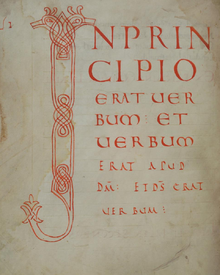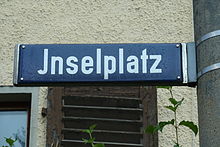J
![]()
This article deals primarily with the origin, representation, and pronunciation of the letter J. For the various meanings of this character, see J (disambiguation). For technical reasons, J# also redirects here; for the programming language, see therefore J-Sharp.
Jj
J or j (pronounced: [jɔt], in Austria and Bavaria also [jeː]) is the tenth letter of the modern Latin alphabet and a consonant. The letter J has an average frequency of 0.27% in German texts, making it the 24th most frequent letter.
The finger alphabet for the deaf or hard of hearing represents the letter J with the closed fist pointing away from the body, while the thumb is in front of it and the little finger is pointing upwards, with the hand making a twisting movement around a vertical axis.
In Morse code, J is written/spoken short, long, long, thus - - -.
In the development of the Latin alphabet, unlike today, I and J were used side by side for a long time as mere graphic variants of the same sign, without any phonetic distinction being associated with them. However, the sign itself was partly used for different sounds.

Letter J in the finger alphabet
Source
|
|
|
|
|
|
|
|
| Arm or hand (protosinaitic) | Phoenician Yodh | Greek iota | Etruscan I | Latin I and J | Latin Sans Serif Jj | |
In the Phoenician alphabet, the character yodh was used to render the semivowel [j], which can be described as both a palatal approximant and an unsyllabic [i]. When the Greeks developed the Greek alphabet from the Phoenician alphabet, they adopted the sign as an iota to write the vowel [i].
The Etruscans adopted the Greek sign, but used it not only to write the vowel [i], but also to write the homophonous semivowel [j] (just as they used the sign V for both the vowel [u] and the homophonous semivowel [w]). The Romans adopted the Etruscan usage unchanged.
In late antiquity, the semivowel [j] developed into a voiced affricate [dʒ]. From this arose the various sounds of the modern Romance languages. Thus, the Latin [j] (e.g. in iustus "just") corresponds to a [dʒ] (giusto [ˈdʒusto]) in modern Italian, to an [x] (justo [ˈxusto]) in modern Spanish, and to a [ʒ] (juste [ʒyst]) in modern French.
Although these considerable phonetic differences had already fully developed in the early Middle Ages, both sounds were still written with the same character until the early modern period, which could sometimes look like a J (as a majuscule), sometimes like an I (as a minuscule). The capitalis of the Romans did not know the graphic variant J yet. In the later uncial, the present form of the J with a small descender is recognizable. The consistent distinction between the letters I and J is said to have been first proposed in the 16th century by the French philosopher Pierre de la Ramée.

"IN PRINCIPIO" - J-form at the initial next to I-form (Gospel Book, c. 870).
Use in the German language
When the German language was written down towards the end of the first millennium AD, the letter I was used twice: On the one hand for the rendering of the unrounded closed front-tongue vowel [i], on the other hand for the rendering of the voiced palatal approximant [j]. Thus, the original Latin double usage was adopted, although the I in its use as a consonant letter in the Romance languages of the time meanwhile denoted another sound, a [dʒ].
"While the gothic alphabet had created a separate character for the semivocal j at the 15th position, the much later upper and lower german, as well as nordic manuscripts, which adopted the latin alphabet, still expressed j by i according to its need, as far as they did not also use g for it. only since the 15th century the use of a separate letter for the semivocal can be proved in the beginnings, and at first only for the minuscule script."
- From: Grimm's dictionary
Because the semivowel [j] persisted in German, the need for a distinction of the consonant letter J from the vowel letter I was less urgent than in other languages. This distinction was therefore not adopted in the writing of German texts until it was already established in other languages. Broken scripts did not distinguish between the majuscules I and J until around 1900. While only the use of the minuscules changed, it was not until after 1900 that broken types showed a distinguishable majuscule-J with an extended bow, as well as a compressed majuscule-I. As far as German texts were set in Antiqua, they already distinguished in the 19th century - just as today - between I/J and i/j.
To this day, there are still older scribes who use a J instead of the capital I (e.g. Jda, Jtalia). Even in sans-serif typefaces, a capital J is sometimes substituted for a capital I. One reason for this is that in such typefaces, the capital I and the lowercase L are often difficult or impossible to distinguish, especially when both letters are next to each other (for example, in Jll, Jller, Jlmenau, Jllustrierte as opposed to Ill, Iller, Ilmenau, Illustrierte).
"Since the Endstrichlosen play such a large role, one seems to think here and there that the I is insufficient and not infrequently substitutes for it the inverted J, that is, an inverted sound. If the I is followed by one or two l's, three naked vertical strokes are formed in the endless line. In a good script, however, these are not of the same size and thickness. At least the I is thicker by a trace. That must suffice."
- Jan Tschichold: Master Book of Writing
For some foreign words, there is both a German spelling with J, valid according to the new German orthography, and a technical spelling with I (e.g. iodine, next to iodine). In chemistry, the spelling with I is even preferred (analogous to citric acid).
Apart from proper names and abbreviations, no word ends in these letters according to spelling.

Street sign at the Inselplatz in Jena with J instead of I in the initial sound
Search within the encyclopedia





